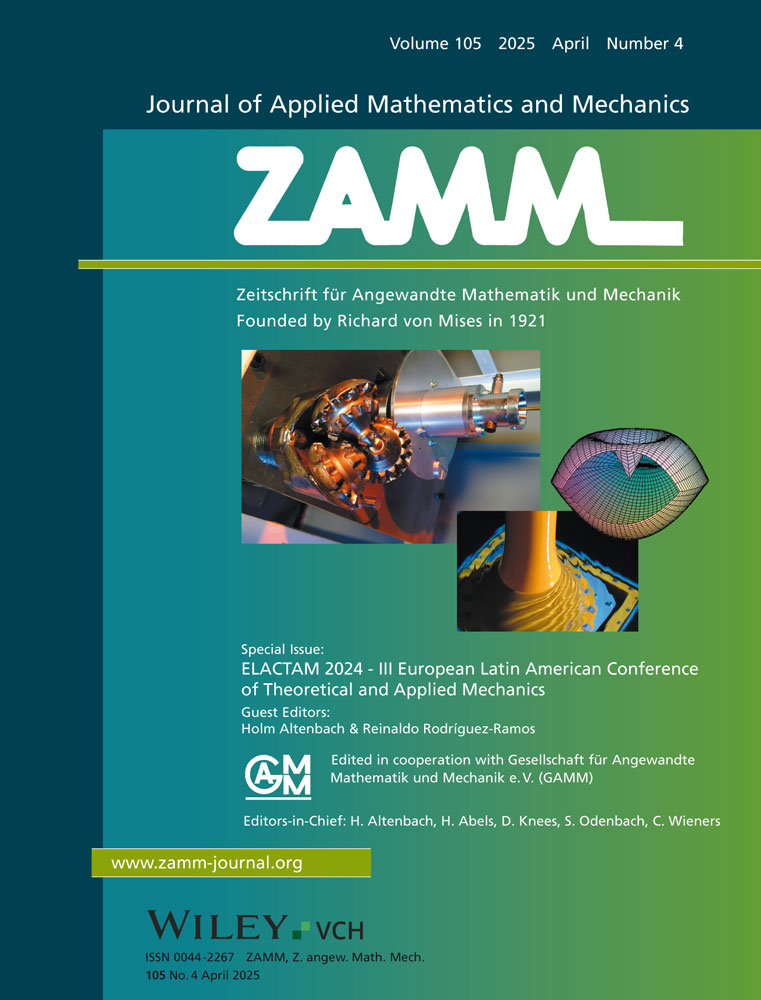Editorial
From January 29 until February 2, 2024, the IIIrd European-Latin American Conference of Theoretical and Applied Mechanics (ELACTAM-2024) took place at the University of Havana. The objective of this meeting was to facilitate the exchange of ideas and experiences between researchers, professors, and students from Latin America with their colleagues from Europe, Asia, and North America. The focus of the third conference centered on topics of mechanics (solid and fluid mechanics, vibrations and wave propagation, new materials and material modeling, biomaterials and material modeling, modeling of green/renewable materials, sandwich materials, and computational mechanics) and its applications.
-
Tahani Al Sariri, Ariel Ramírez Torres, and Raimondo Penta present a paper devoted to a new multiscale model describing fluid flow actively responding to the application of an external load in a vascularized, partially cancerous tissue. The results can be helpful, for example, in improving drug delivery.
-
In the submission of Ariel Ramírez Torres, Alejandro Roque-Piedra, Alessandro Giammarini, Alfio Grillo, and Reinaldo Rodríguez-Ramos the focus is on deduction analytic expressions for the homogenized coefficients that describe the mechanical behavior of a uniaxially fiber-reinforced composite material consisting of two solid constituents undergoing inelastic distortions, one representing the extracellular matrix, and the other representing the inclusions that model the fibers. The motivation stems from the need to characterize the global properties of biological tissues that can alter their mechanical properties in response to permanent transformations, interpreted, in the formulation, through the concept of inelastic processes.
-
Soraya Bakhouchea, Magdalini Titirlaa, and Walid Larbi have focused in their contribution on the optimization of the acoustic insulation performance of a wooden floor with joists, on which a layer of porous material is installed to reduce its sound transmission, mainly in the low-frequency range. Such research may have a substantial influence on a structure's comfort, safety, and sustainability over time.
-
Panters Rodríguez-Bermúdez, Dan Marchesin, and Eron Oliveira do Nascimento deliver a submission on a class of Riemann Problems for immiscible vertical three-phase flow in porous media for the general case in which all fluids have distinct densities and the convection occurs solely due to gravity effects. The results obtained in this work represent another important step toward the understanding of gravity effects in general three-phase flow.
-
Zhenghao Yang, Konstantin Naumenko, and Holm Altenbach derive analytical solutions to peridynamic Kirchhoff type (shear rigid) plate equations for both static and dynamic cases. The results are validated by comparing against solutions to the classical plate theory (CPT) for both static and dynamic cases.
-
Caroline Bauzet, Serge Dumont, Frédéric Lebon, and Flore Nabet propose two families of models for damaged materials that take uncertainties into account. This work is the first in the field of materials damage to couple a non-regular mechanics problem with a temporal stochastic integral.
-
Michele Serpilli, Raffaella Rizzoni, Frédéric Lebon, and Reinaldo Rodríguez-Ramos present a size-dependent model for a laminated micro-beam with a soft adhesive which is developed in the framework of strain gradient elasticity theory. The examples show the efficiency of the proposed approach in designing micro-scale layered beams.
-
Yoanh Espinosa-Almeyda, Reinaldo Rodríguez-Ramos, José A. Otero, Héctor Camacho-Montes, and Panters Rodríguez-Bermúdez discuss heterogeneous micropolar elastic fiber-reinforced composites with a periodic structure are analyzed using the two-scale asymptotic homogenization method. The introduced method is a very efficient and precise way to model heterogeneous micropolar materials. It allows for finding analytical expressions of effective properties that do not require a high computational cost.
We hope that the special issue will generate interest among readers and possibly motivate them to attend the next conference (expected February 16–20, 2026 in Havana).
Holm Altenbach & Reinaldo Rodríguez-Ramos
Editors of the Special Issue ELACTAM-2024




